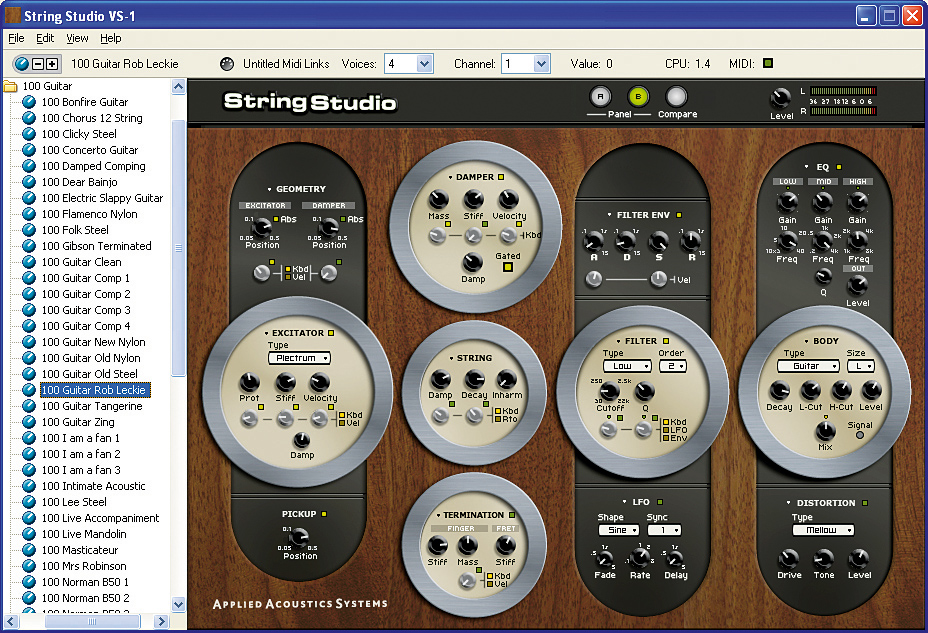MusicRadar Verdict
Clever technology, but not massively flexible, and you may tire of the sounds.
Pros
- +
Great acoustic guitar simulations. Intuitive operation. Dynamic and expressive sonic performance. Simple and attractive screen layout.
Cons
- -
Very CPU-intensive. Stability problems on some presets. Limited sound generation possibilities.
MusicRadar's got your back
The first thing to point out about AAS String Studio is that it doesn't synthesize 'strings' in the orchestral sense of the word.
Although it is polyphonic, it's designed for modelling individual strings; those of a guitar, for example, or perhaps a classical harp or a double bass.
If your goal is to create lush string sections, you should look elsewhere. String Studio uses Applied Acoustic System's physical modelling technique to create its sounds.
The Exciter module models the way a plectrum, hammer or bow interacts with a string, and this drives the self-oscillating String module, the characteristics of which are further modified by both Damper and Termination modules.
The output is then fed through the traditional, synth-style Filter module, which has its own envelope controls. The sound that results from this process is - in itself - not particularly inspiring, but it's totally transformed by the remarkable Body module.
You can think of this as being a bit like an ultrashort reverb, or (perhaps more accurately) like the cabinet simulator in a high quality guitar amp modeller. The Body module does a stunningly realistic job of recreating the boxy resonance of the wooden bodies of guitars, pianos and violins of various sizes, and really does have to be heard to be believed.
Finally, the sound is passed through the Effects module. Although this contains just the standard fare of chorus, delay and reverb, the effects are all of excellent quality and well worth experimenting with.
Want all the hottest music and gear news, reviews, deals, features and more, direct to your inbox? Sign up here.
Good interface
The screen layout of String Studio is a triumph of user interface design. You simply don't need to refer to the documentation, as after just a few minutes of experimentation every control's function becomes obvious.
However, the manual does contain detailed explanations of each, and features clear diagrams and musician-friendly language. It doesn't take too long to discover that String Studio is at its best when reproducing classical guitar sounds and simple keyboard instruments such as the clavinet and harpsichord.
The pianos (both electric and acoustic) are rather poor, and the bowed sounds are unconvincing and somewhat unstable. Additionally, the Distortion module (presumably included to work with the electric guitar presets), provides a very unpleasant and unmusical tone and is best avoided. The good news is that there's plenty to experiment with.
The Damper module - which is responsible for the extremely accurate release phase of the guitar sounds - is so flexible that it can be made to physically 'bounce' on the strings (a bit like throwing a rubber ball into a piano).
This is not particularly useful, admittedly, but it's certainly good fun to play with. Furthermore, String Studio contains the excellent semi-programmable arpeggiator that featured in AAS' Ultra Analog synth.
Drawbacks
Although AAS have tamed and refined their physical modelling technology over the years, there are still some problems.
It's very difficult to get the Bow exciter module to behave reliably without starting from an existing preset, for example, and many of the sounds become unstable - in terms of both tone and tuning - at the extremes of the keyboard range.
Also, because of the way physical modelling works, some arbitrary notes can behave unexpectedly, which is both annoying and often impossible to cure. The 'pad' sounds are interesting, but this is mostly because of careful effects processing on otherwise unimpressive sounds.
As such, it's hard to get too excited by them: you could achieve similar results yourself by using a middle of the road soft synth and the built-in effects in your host sequencer.
On the plus side, though, String Studio is capable of creating some fairly realistic Xylophone and Marimba sounds. String Studio's party piece is undoubtedly its ability to create convincing acoustic guitar sounds.
Despite a lack of attack in the low registers, the level of realism is extremely impressive. Although you wouldn't fool a guitarist into thinking that these sounds came from a particular brand of guitar, they do at least sound like they were played on a genuine physical instrument of some kind or another.
The stability of AAS software has improved greatly since the early versions of Tassman, and String Studio seems to be totally bug-free.
But although the software is certainly technically impressive, we have to ask whether we'd really want to spend our cash on a necessarily limited number of sounds that are already available in more versatile and CPU-friendly pieces of software.
Although String Studio is highly commendable in many respects - and contains some unusual tones - our view is that, sooner or later, most people will tire of its limited sound palette and realise that they can generate similar (or better) results by using a more flexible synth or a carefully mapped set of multisamples.
That said, if samplers and high-end synthesizers completely baffle you, and you want easy access to some highly expressive and tweakable sounds via a simple and understandable user interface, String Studio could be the solution.
Computer Music magazine is the world’s best selling publication dedicated solely to making great music with your Mac or PC computer. Each issue it brings its lucky readers the best in cutting-edge tutorials, need-to-know, expert software reviews and even all the tools you actually need to make great music today, courtesy of our legendary CM Plugin Suite.

